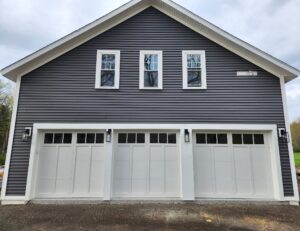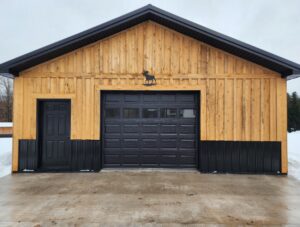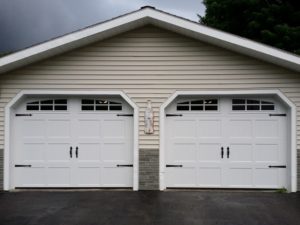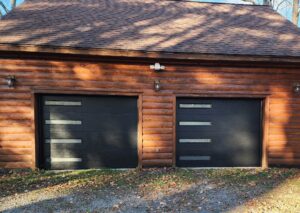Updated on August 24, 2022 12:48 pm
The historic Belden Tunnel which gives the railroad passage through Belden Hill had a new overhead door installed on its south portal last December. The job was done by local garage door contractor, Choice Garage Doors out of Afton.
In September 2015, Norfolk Southern Corporation (NSCorp) acquired 282 miles of the Delaware & Hudson’s Railway Co.’s (D&H) line between Sunbury, PA., and Schenectady, NY. This includes the rail line that runs through our beautiful rural community.
The Belden Tunnel is situated on this main line about 10 miles due west of Afton. Canadian Pacific, which D&H is a subsidiary of, has also attempted to acquire all of fellow rail giant NSCorp in recent months, but the attempt was unsuccessful.
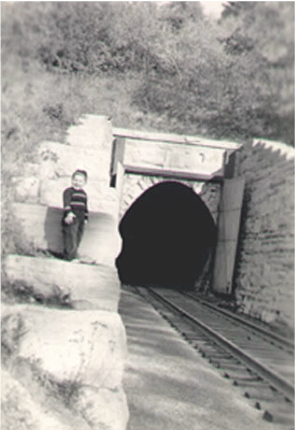
History of Belden Tunnel
The original “Belden Tunnell” was built to overcome Belden Hill. Belden Hill was the last and most difficult obstacle to complete the Albany & Susquehanna Railroad line (A&S) going from Schenectady/Albany to Binghamton. In the 1840s the need for the construction of a rail line going Albany to Binghamton was evident, and the stock of the Albany and Susquehanna Railroad Co. was established in 1851. Funds were raised the following year.
Construction began in the 1850s
Construction of the A&S began in 1853 and continued on and off for 15 years. The A&S was being built from Albany to Binghamton and opened for business to Sidney on October 22, 1866; Bainbridge, July 10, 1867; Afton, November 11; and Harpursville on Christmas day. Even though the excavation of the tunnel started around two years before Sidney had rail service, the tunnel project hindered the A&S from connecting to Binghamton till January 1869.
The tunnel’s excavation began from both ends in 1864, and four years later on December 31, 1868, the last rail was laid to join the north and south tracks. It was originally 2,239 feet long and was mostly lined with timber except for approximately 400 feet combined on both ends that were lined with brick. On January 14, 1869, the Albany & Susquehanna Railroad opened service for its entire length from Albany to Binghamton.
The Battle of Belden Hill
Less than a year later, on August 10, 1869, the Battle of Belden Hill took place. The Albany & Susquehanna line was promising a lot of revenue. Joseph H. Ramsey, Albany & Susquehanna’s president at that time had entered into a contract to bring coal up from the PA mountains to Albany. Coal was the most demanded commodity of the time.
Besides this contract, there were a lot of other factors that made this line a promising connection. Ramsey had developed this railroad into such a promising financial asset that Jay Gould and Jim Fisk, who had recently gained control of the Erie Railroad, tried to gain financial control of the Albany & Susquehanna as well.
They set about to purchase stock in the company and tried to gain control. This resulted in a long legal battle. At one point both parties had been appointed receivers of the railroad by two different courts. This resulted in the A&S men throwing Erie men out of the Albany offices and Erie loyalists in Binghamton controlled that portion of the railroad.
On August 9, a train with Master Mechanic, R. C. Blackall went south with 400 men on board to meet and overpower any persons loyal to Erie. At Bainbridge, they derailed and surrounded a northward trainload of Erie men and Broome County Sheriffs who had come from Binghamton to depose all A&S officials at every station. Erie men and sheriffs spent the night in Bainbridge in armed captivity. The A&S train then continued south around 10:00 am after releasing their “prisoners” and came as far as Harpursville where they learned what they were up against.
Blackall telegraphed Van Valkenburge that “Erie folks are preparing to move upon us. They have the militia with them.”
Without awaiting a reply from the superintendent, the A&S train continued south through the night. The Broome county sheriffs and Erie men in Bainbridge had left for Binghamton via horses and wagon.
Another trainload of Erie men had come up and were at the south portal of Belden Tunnel. Blackall’s train was arriving at the north portal. The tunnel was a barrier between the two. Neither crew would have wanted to meet and collide with the other inside the tunnel. Late that day the Erie men proceeded through the tunnel and their train met the A&S train on the curve just outside of the tunnel. The trains collided and the A&S train derailed. However, the A&S men succeeded in scattering the Erie men and the Erie men receded back into the tunnel and up into the hillsides. The A&S men were able to re-rail their train and proceeded through the tunnel when darkness came.
At the south portal, both sides fought with fists, clubs, and revolvers. The fight was broken up by the state militia that had been called out by Broome County officials. New York State Governor John Hoffman took temporary control of the railroad and designated individuals to keep charge of the road. Later it was decided that A&S was to remain in the hands of President Ramsey and his officers. However, on February 24, 1870, Ramsey and his board leased in perpetuity the A&S to the Delaware & Hudson Canal Company (D&H). Though there were injuries, including several reported gunshot wounds, there were no lives lost in the brawl.
The Historical Tunnel Soon Becomes Problematic
Ice build-up has been a problem, both icicles from the ceiling and ice build-up on the tracks. Photo from a Binghamton paper dated April 23, 1978- courtesy of Afton Historical Museum.
The tunnel has had a long time history of ice build-up problems and has had multiple doors installed throughout its history to help keep the warm air inside. On December 9, 1869, just a little less than a year after the line opened for service, Binghamton Republican reported that a southbound passenger train from Oneonta ran into the closed 3” thick wooden doors. There was a lot of damage, but there were no deaths.
The ice build-up caused a man’s death in the tunnel in the 1920s. The linemen would shoot at the ice with shotguns to knock it down. After one crew had shot at the ice in the exhaust vent, another crew came along to clean up what was on the ground. One of the clean-up crew’s men was under the exhaust shaft when an approximately 800 lb. chunk of ice fell down. The mass of ice had evidently been loosened but didn’t fall till later.
The vertical exhaust vent was bored through the mountain in 1908 to allow the exhaust from steam engines to escape the tunnel. The rail line crests in the center of the tunnel, so the exhaust would naturally vent out through the vertical bore. In 1941 the tunnel’s floor was lowered two feet to accommodate the newer, larger engines. The most recent and major enlargement started in July of 1985. The tunnel was enlarged to be around 18 feet wide and the crown was made to be just over 26 feet above the tracks. This enlargement allowed double stackers to fit through, and also lengthened the tunnel by 31 feet.
The tunnel was back in service in December of the same year. Included in this improvement were a new automated garage door and a building towering over 50 feet from the tracks to accommodate the vertical lift for the door to open.
New Roll-Up Door Provided By Choice Garage Doors
Sometime since then, the vertical lift door was replaced with a roll-up door. NSCorp decided to replace the roll-up door on the south end because of the problems strong winds were causing. If there was a strong air current going through the tunnel while the door was closing or opening it would bind and get stuck. This is where Choice Garage Doors came in. The new system was suggested by Choice Garage Doors as a solution to the costly problems of the old door getting stuck in the down position with a trainload of freight pulling up one of the large slopes. Like a standard garage door, this new door rolls on rollers much like wheels inside the track. This allows the door to operate with minimal friction even during a strong wind current.
The new system is a vertical lift, sectional style door and is designed to withstand winds over 100 mph. It weighs around 2,200 lbs. and is counterbalanced with weight ballasts, providing greater dependability and less maintenance than a standard spring counterbalanced system. It is just over just 18 ½ feet wide and towers 26 feet high. The door is operated automatically with an electric operator that is controlled by the railroad signal system and can be controlled by the NS Corp dispatcher in Harrisburg, PA.
The New Belden Tunnel
Being a vertical lift door, it opens straight up so the top of the door is over 50 feet above the railroad track when in the fully open position. The door panels were made in Ohio, and the counterbalance system, extra heavy-duty tracks, hinges, and rollers were trucked in from Manitoba, Canada.
Choice Garage Door owner, Ivan Byler states “The project was a lot of fun, and just up my alley. I am always up to a good challenge!”
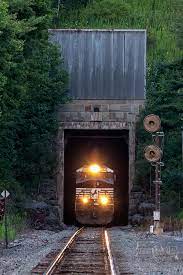
Places to Further Your Belden Tunnel History
Anyone interested in reading more history of the tunnel, or how the A&S has shaped our communities may be interested in the books by John Taibi entitled, “Roads, Rivers, and Rails – Volume I & II.” Mr. Taibi did an exceptional job of taking us back to the “yesterday” of our local area, especially in relation to railroads. It is loaded with both old and new photographs and a great deal of history.
Both Volume I and Volume II are great reads. Volume I covers Albany/Schenectady to Oneonta and Volume II covers Oneonta to Binghamton. Because of the tunnel’s importance to making a railroad from Albany to Binghamton possible, the tunnel is talked about in both issues. There is a copy of both available at the Afton Free Library. The Afton Historical Museum also has copies of old news articles with much more information.









